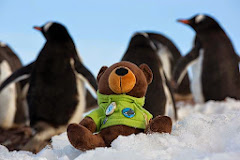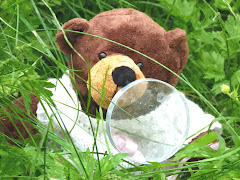Sam was dying to go for a swim. He said sea lions are happy to be out of the water for long periods of time, but his fur gets very itchy after a while a good swim would sort it out. Sam invited me to go surfing. Sam said he keeps a spare surf board and wetsuit in the back of the car when he is travelling, just incase he needs to lend it to anyone. Sam, of course doesn’t need one as he can surf the waves with his body.
Sam said I would need a wetsuit as the water is very cold. I asked Sam if he would feel the cold. He said, like many other marine mammals he had a thick layer of blubber, or fat, which keeps him warm. He said it works just like a wetsuit. In fact, the sea otter, that also lives along this shore, is the only marine mammal that does not have blubber. Instead, sea otters have a lot of hair: 170,000 to 1,000,000 hairs per square inch!
(c) Madralynn Haye Marine Photobank
That's a lot more than my fur. Sam said Sea otters have so much hair that their skin never gets wet! That is why sea otters do not need a wet suit and I do.
Surfing was great fun and I learned some science too. Waves are created when the wind blows over the sea. The friction between the wind and sea transfers some of the winds energy into the ocean. This makes a wave which travels across the ocean as a wave of energy. (Try blowing the surface of the water in washing up bowl. This will make a small wave).
As the wave gets nearer the coast, friction plays another role, this time at the bottom of the wave. Friction between the bottom of the wave and the seabed slows the wave down and makes it taller - now it looks more like a wave. As the wave moves nearer to the beach, the friction slows the bottom of the wave down so much that the top of the wave topples forwards and breaks with crash of spray and foam. But thats not all. If I stay still on my surf board I will just bob up and down as each wave goes past.
North of Kalaloch is La Push, home of the Quileute Tribe. For those of you who are Twilight movie buffs, Bella’s friend Jacob is Quileute and goes to school in La Push. My buddy Steve's daughter is a great twilight fan, the books and the movies, she will be so jealous.
The most northwestern point of this area of the US is Cape Flattery which is on the Makah Indian Reservation. Jacqueline said that this year the Makah Tribe is hosting tribal journeys. Tribal Journeys is a weeklong event that celebrates the canoe culture of the Northwest Coast Native Americans and First Nations. I wish I could stay around and take part.
I really enjoyed my visit to the Olympic coast. I hope I will get to return soon and maybe even go out on a boat to tour the Sanctuary and see some of the amazing marine life that lives in the ocean.
Back to the Hawaiian Islands for my next stop to help out with studying humpback whales. I might even get to try my underwater housing in the ocean for real.
Bye for now, Ed and Sam










No comments:
Post a Comment